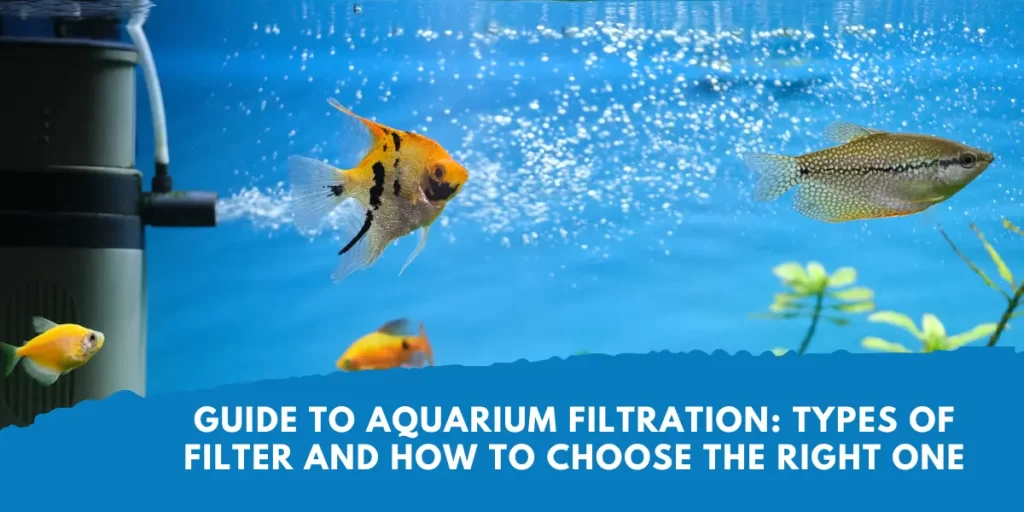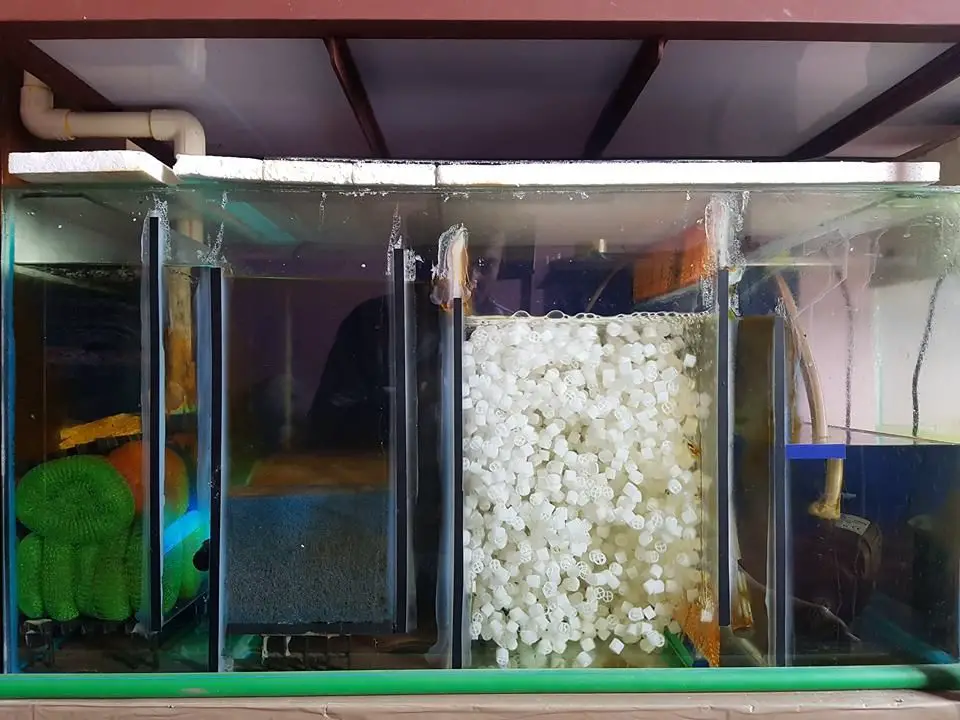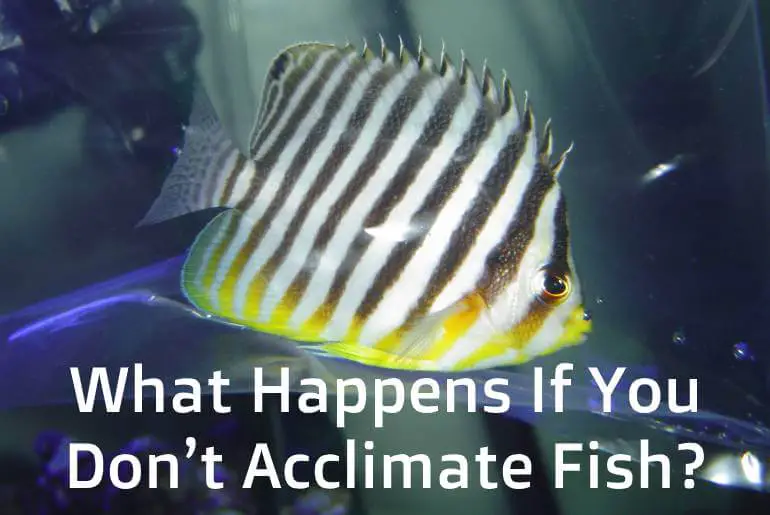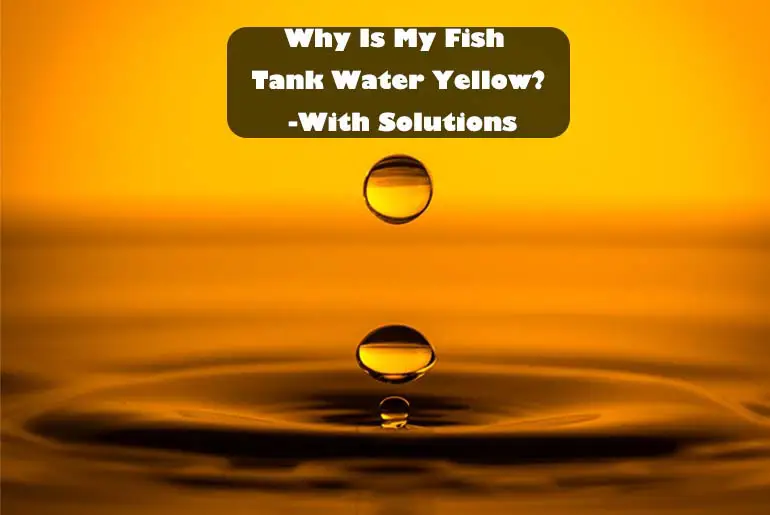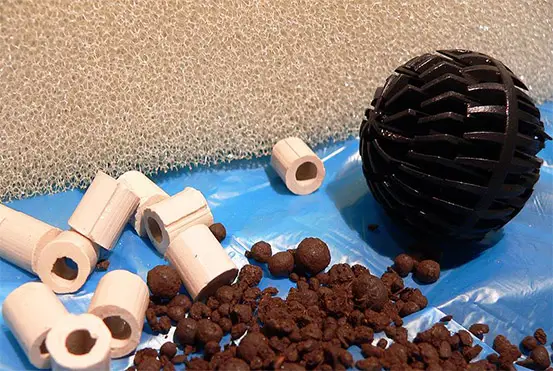Keeping fish as pets have become quite popular among individuals of all living arrangements, regardless of the size of their space. Whether you live in a small apartment or a spacious house, having an aquarium is a wonderful way to bring the beauty of aquatic life into your home. However, it is crucial to recognize that an aquarium functions as a closed environment, requiring diligent care to ensure a healthy habitat for your fish. With a proper aquarium filtration system, the well-being of your fish can be maintained. Therefore, selecting the appropriate filter and providing adequate aquarium maintenance is paramount.
Aquarium filters come in various types, each offering distinct advantages and limitations. Determining the ideal filter for your specific needs relies on factors such as tank size, the species and quantity of fish, and your budget. In this guide, we will explore the diverse range of aquarium filters available and examine their functions, empowering you to make an informed decision that best suits your aquarium’s requirements.
Why Do You Need A Filter In Your Aquarium?
In an aquarium, fish create organic waste that can quickly build up and make the water dirty and unhealthy. But don’t worry! Filters rescue by keeping the water clean and healthy for your fish.
A filter removes waste and harmful toxins like ammonia and nitrates. It purifies the water, ensuring your fish can breathe and swim easily.
If you don’t have a filter, the nitrogen cycle won’t work effectively, and harmful toxins will accumulate in the water. This can make your fish sick and even lead to their unfortunate demise due to pathogens, toxins, and a lack of oxygen.
That’s why having a filter in your aquarium is necessary. It helps to keep the water clean and safe, creating a healthy environment for your fish to thrive in.
If you’re curious to learn more about the process behind all of this, it’s called the Nitrogen Cycle. You can click the Nitrogen Cycle link to delve deeper into this fascinating topic.
Understanding the Nitrogen Cycle will give you valuable insights into how your aquarium’s filtration system works and how it contributes to maintaining a clean and healthy aquatic environment for your beloved fish.
Here is a step-by-step guide to setting up your aquarium.
How Does An Aquarium Filter Work?
An aquarium filter works like a normal filter to purify drinking water. It removes impurities from water by following certain steps, so here’s a step-by-step explanation of how an aquarium filter works:
- Water is drawn into the filter by a pump or gravity, depending on the type of filter.
- The water passes through mechanical filtration media, which captures larger debris such as uneaten fish food, plant matter, and fish waste. This media can be a sponge, foam, or filter pad.
- The water then passes through biological filtration media, such as ceramic rings or bio-balls, which provide a home for beneficial bacteria. These bacteria break down harmful compounds like ammonia and nitrite into less harmful compounds like nitrate.
- Some filters may also have chemical filtration media, such as activated carbon or zeolite, which can remove dissolved organic compounds, odors, and discoloration.
- The filtered water is then returned to the aquarium through a return outlet, a spray bar, or a nozzle.
Chemical media, unfortunately, kills all the bacteria in your tank water, including the beneficial ones. This is because only the mechanical and biological media helps to colonize beneficial bacteria.
The bubbles play an important role in the aquarium. They create agitation and movement in the water, which helps in effective gas exchange. Oxygen from the air is transferred into the water. Carbon dioxide and other gasses are released from the water into the air.
But here’s the thing: the filter can only do so much. It’s up to you to lend a helping hand by performing frequent water changes. This means removing dirty water and replacing it with fresh and clean water.
Also Read: Why Do Fish Tanks Get Dirty So Fast
Important Components: A Good Filter Should Have
No aquarium filters are made the Same. Still, all good-quality aquarium filters have the same components. The three main components required in a quality aquarium filter are mechanical, chemical, and biological media. This article on Aquarium Filter Media Order will guide you through why it is necessary to maintain the order of the media.
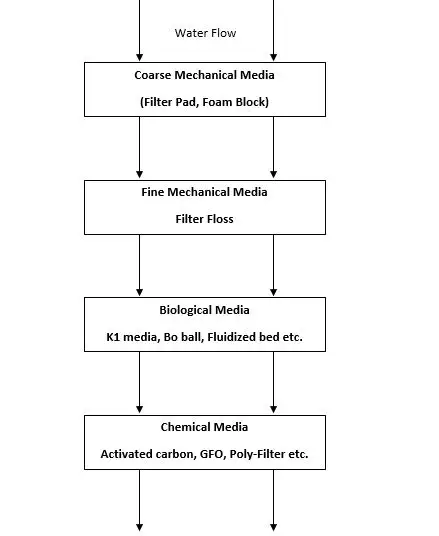
Mechanical Filtration
Mechanical filtration plays a fundamental role in aquarium filters by physically capturing and removing debris and particles from the water.
It uses special filter media, like a sponge, foam, or filter pad, to trap larger debris such as uneaten fish food, plant matter, and fish waste.
So, why is mechanical filtration important? Well, its main purpose is to prevent dust and solid waste from breaking down and causing issues with water quality.
If these wastes remain in the water, they can clog other filter media, like bio-media, which are responsible for hosting beneficial bacteria.
When these bacteria can’t survive due to clogging, it leads to poor water quality, chemical imbalances, and potentially harmful living conditions for your aquatic pets.
Therefore, mechanical filtration will ensure the water remains clean and healthy for your aquarium inhabitants.
The article Why should you use aquarium filter floss can be valuable if you want to learn how these media can help clear up your cloudy and dirty aquarium.
Biological Filtration
Biological filtration is a fundamental component in keeping your aquarium or aquatic environment healthy, and you should pay attention to it.
This filtration system relies on special bacteria that help break down harmful waste produced by fish and other aquatic organisms, transforming it into less toxic substances.
Various biological filters, such as trickle, canister, and fluidized bed filters, are available, each with advantages and disadvantages.
These filters provide a suitable environment for the beneficial bacteria to grow and live, allowing them to break down waste materials in the water efficiently.
The bacteria present in a biological filter perform a two-step process. Firstly, they convert highly toxic ammonia into nitrite, which can harm fish. This conversion helps to reduce the toxicity of the waste in the water.
Then, another type of helpful bacteria converts nitrite into nitrate, which is much less harmful to fish and plants.
Nitrate can be removed from the water through regular water changes or absorbed by live plants, which utilize it as a nutrient for growth.
Chemical Filtration
Chemical filtration is a method that helps to remove impurities and harmful substances from aquarium water that other filtration methods cannot effectively eliminate.
It’s important to note that different chemical filter media are designed to target specific impurities such as organic compounds, phosphates, heavy metals, and medication residues.
Each type of media has its unique properties and capabilities. As a result, some may be more effective at removing certain substances than others. For example, chemical filtration involves using a special filter media, such as activated carbon or zeolite.
Activated carbon and zeolite are porous materials that trap or absorb impurities and harmful substances in the water.
Another type of chemical filter media is phosphate-removing media. This chemical media specifically targets and removes these phosphates, helping to control algae growth and maintain a healthier environment for the fish and other aquatic life.
So, it is essential to choose the appropriate chemical filter media based on the specific needs of your aquarium.
Recommended Article: Cloudy Water In Aquarium: Cause And Prevention
UV Light(Optional)
UV light is handy for keeping aquariums and other aquatic systems nice and clean.
It makes the water sterile by removing harmful microorganisms like bacteria and viruses. This helps prevent the spread of diseases and ensures that the water remains clean and safe for fish and other aquatic creatures.
In aquariums, UV light is often used alongside other filters to maintain clean water. First, the water is mechanically filtered to remove big debris, then goes through biological filtration to eliminate waste products.
Finally, the water passes through the UV sterilizer to destroy any remaining microorganisms.
But you should remember that UV light should not be the only filter you depend on. You still need mechanical and biological filters to take care of dust and waste products in the water. UV light is a valuable tool to use alongside these filters to keep the water clean and healthy for your aquatic friends.
Also Read: How To Get Aquarium Water Crystal Clear.
10 Different Types of Aquarium Filters
We have discussed how filtration systems work. Now let’s have a look at some of the aquarium filters for your freshwater tank:
Undergravel Filter
The under gravel filter is popular and affordable, especially for small aquariums or ones with just a few fish. It’s a special type of filter that you place under a layer of gravel in the aquarium.
This under-gravel filter is important for keeping your aquarium clean and healthy. It actively removes harmful substances from the water and facilitates the growth of beneficial bacteria.
In the same way, you can improve the health of your fish and promote a balanced ecosystem within your aquarium.
One drawback of the filter is that if you ever need to clean the under-gravel filter entirely, you must remove everything that sits above the filter, i.e., gravel and decorations.
However, remember that chemical filtration does not occur in under-gravel filters, so you may need to consider adding a chemical filter if your tank requires it.
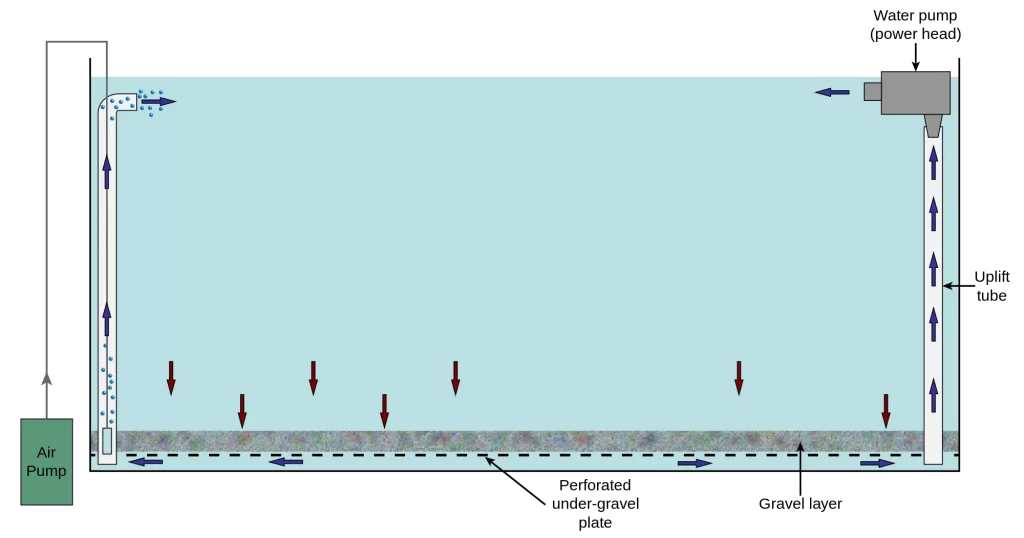
Working Mechanism
- At first, an air pump forces air into the under-gravel filter, forcing air to escape from the exit nozzle.
- Then, the water flows through the gravel, creating a bacterial bed that helps break down waste and other impurities.
- The water is then pulled up through the lift tube and back into the aquarium, which is oxygenated before recirculating through the gravel bed.
| Pros | Cons |
| They are relatively inexpensive compared to other types of aquarium filters. | They are not suitable for tanks with a gravel substrate or tanks with live plants, as the roots of the plants can interfere with the filter. |
| Undergravel filters are easy to clean and maintain, as it just requires a filter plate and an air pump to work. | Undergravel filters provide only limited mechanical filtration, which may not be suitable for tanks with a high bioload. |
| These filters provide excellent biological filtration, helping keep your tank’s water clean and clear. | Setting up properly can be difficult and require trial and error to get the water flowing right. |
| It can be a good option for small or low-tech setups, as it does not take up space inside the aquarium. | The accumulated waste in the gravel of under-gravel filters can create anaerobic conditions and produce harmful gases if not maintained and cleaned regularly. |
Box Filter
A box filter is a more modernized and compact version of an under-gravel filter. It is placed inside the aquarium and can be attached to the side or on the gravel bed.
This type of filter is commonly used in freshwater and saltwater aquariums, especially in small to medium-sized tanks.
Box filter consists of plastic or glass box with compartments for mechanical, biological, and sometimes chemical filtration.
The mechanical filter media traps larger debris, while the biological media supports beneficial bacteria for essential biological filtration.
Some box filters also have a section for chemical filter media to remove impurities or odors.
Box filters are versatile, easy to maintain, and cost-effective, making them popular among aquarium enthusiasts.
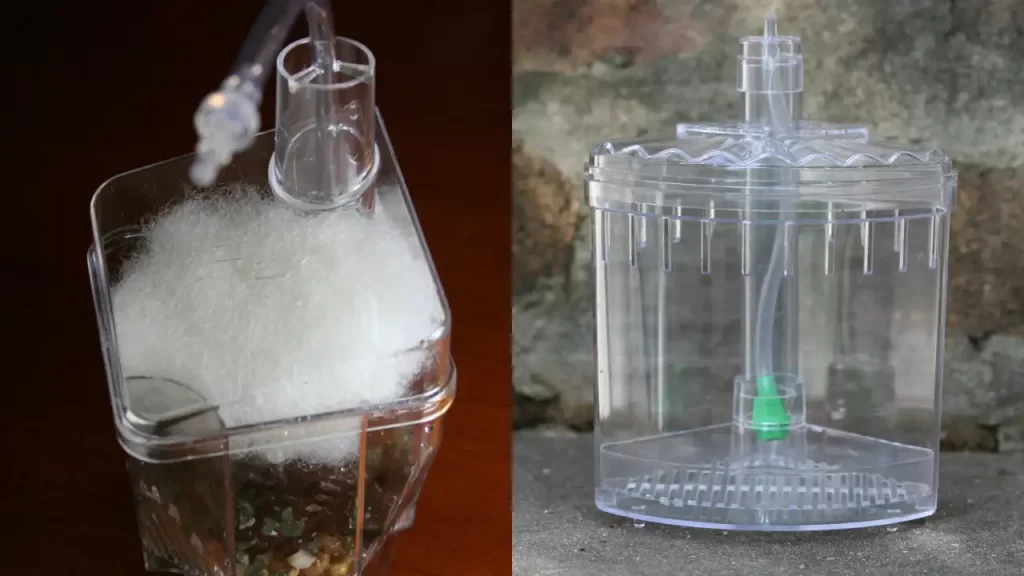
Working Mechanism
- First, the air is forced out of the outlet of the filter.
- Water then enters the box filter through an intake section.
- The intake section has mechanical filter media, such as foam or floss, which traps larger debris and particles.
- The water then flows into the biological filter section, where beneficial bacteria colonize the biological filter media.
- The bacteria break down harmful substances, such as ammonia and nitrite, into less toxic forms through biological filtration.
- Some box filters may have a separate compartment for chemical filtration, where specific filter media like activated carbon or chemical resins can be used to remove impurities or odors from the water.
- The filtered water is then returned to the aquarium, providing clean and healthy water conditions for the aquatic inhabitants.
| Pros | Cons |
| Box filters are easy to take apart and clean, making maintenance simple. | The filter box occupies more space in the aquarium, potentially affecting the fish’s aesthetics and swimming space. |
| The filter media in a box filter can effectively remove dirt and provide a surface area for beneficial bacteria to grow and perform biological filtration. | Filter media in a box filter may need regular replacement to maintain optimal filtration efficiency. |
| Box filters can be easily customized with different filter media to suit specific filtration needs. | Box filters may have a limited capacity for handling large volumes of water or heavily stocked aquariums. |
Internal Power Filters
Internal power filters are popular and versatile aquarium filters used in small and large tanks.
These fully submerged filters provide excellent filtration and water movement, and some models even include UV sterilization for added bacteria and algae control.
Internal power filters are cost-effective but costlier than box and under-gravel filters. However, these filters are easy to use and customizable to suit your aquarium needs, making them a preferred choice for many enthusiasts.
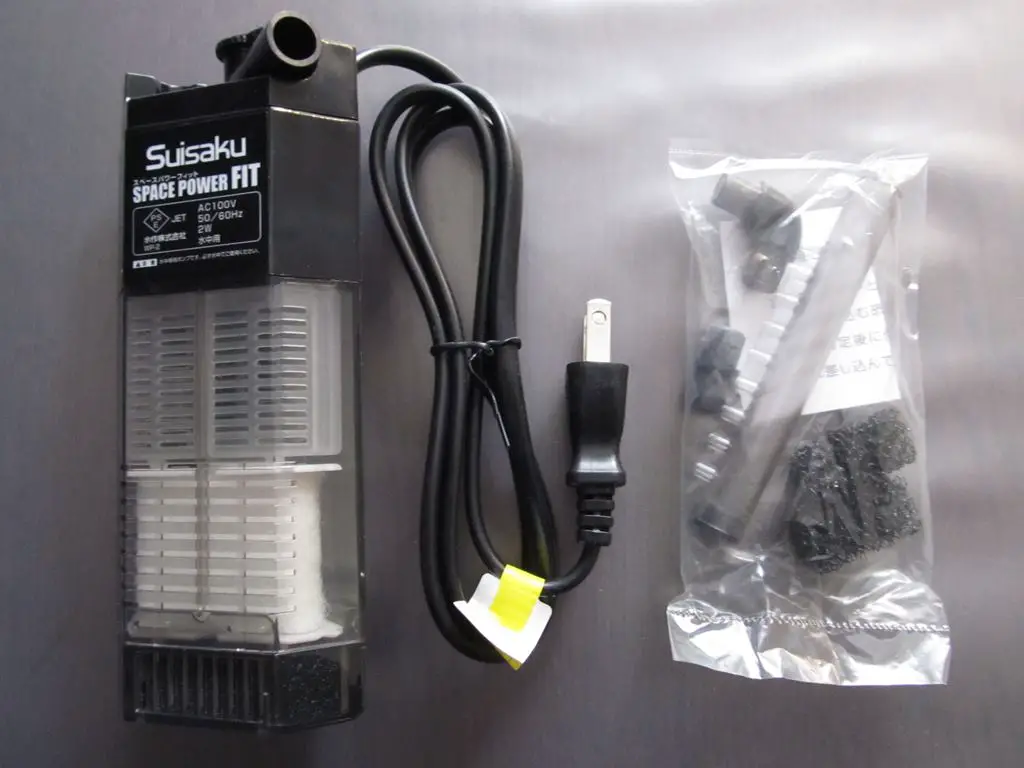
Working Mechanism
- A small turbine-like magnet rotates inside the main filter that sucks in the water.
- The water is passed through a mechanical filter, such as a sponge or floss, which traps junk and waste.
- The water is passed through a biological filter, such as ceramic rings or bio-balls, where beneficial bacteria break down harmful waste compounds.
- The filtered water is returned to the aquarium through an outlet nozzle.
| Pros | Cons |
| Most internal power filters have adjustable flow rates, allowing you to customize the water flow to suit the needs of your aquarium inhabitants. | Internal power filters are typically designed for small to medium-sized aquariums, and more than one internal filter may be required for larger aquariums. |
| Internal power filters provide mechanical, chemical, and biological filtration by utilizing multiple filter media to remove debris and chemicals and support beneficial bacteria growth. | These filters may cause water turbulence, temporarily reducing water clarity. |
| Internal power filters are small and do not take up little space in the tank, making it easy to place and maintain the aquarium’s clean and organized appearance. | This filter may not be as customizable as external filters, as they typically come with pre-set filter media configurations. |
| It is cost-effective, offering effective filtration at an affordable price, making them a budget-friendly choice. | Internal power filters may be unsuitable for large or heavily stocked aquariums as they have a limited filtration capacity. |
| Internal power filters are easy to install since they have all the necessary components and don’t require additional equipment. | Some internal power filters can generate noise during operation, which may be bothersome in quiet environments. |
Here is a detailed article on why you should use two or more filters in an aquarium.
Hang-On-Back Power Filters
Hang-on-back filters, also called power filters, are a type of filter that you hang on the back of your aquarium. They’re easy to use and help keep your aquarium water clean and healthy.
These filters stay outside the tank and simplify changing the filter media or material. They also make your aquarium look nice because you only see a little equipment inside.
Hang-on-back filters are a good choice for people who want a budget-friendly and effective way to keep their aquarium clean.
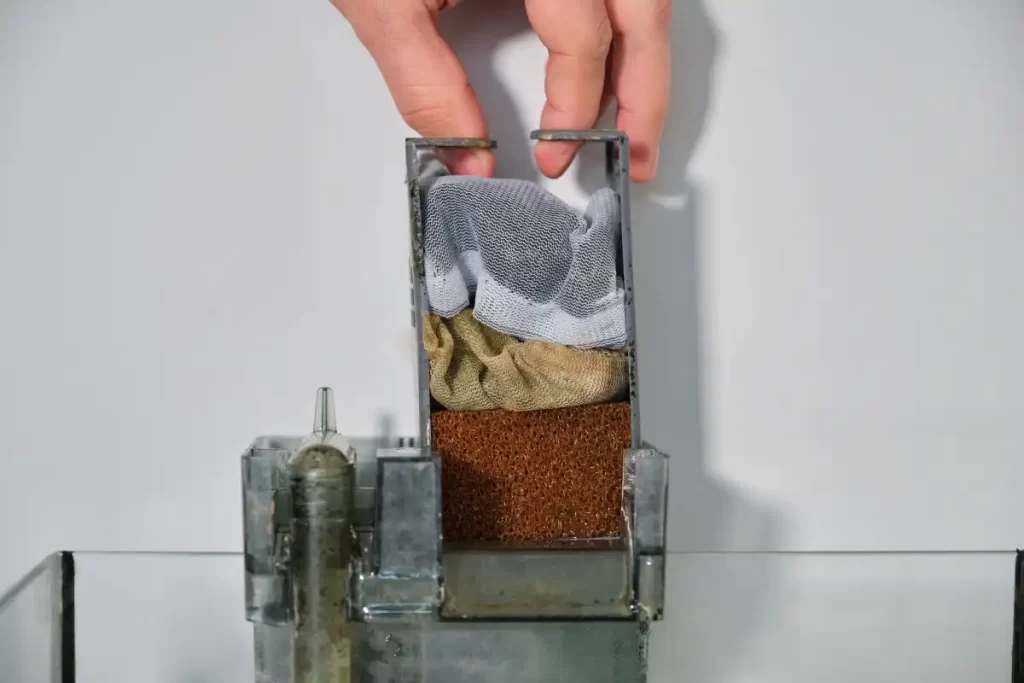
Working Mechanism
- Water is drawn into the filter through an intake tube.
- The water is passed through a sponge or floss, which traps debris and waste.
- The water is passed through a biological filter, such as ceramic rings or bio-balls, where beneficial bacteria break down harmful waste compounds.
- The filtered water is returned to the aquarium through an outflow tube.
| Pros | Cons |
| HOB power filters are generally easy to install and maintain, as they are designed to be user-friendly. | This filter is more suitable for smaller to medium-sized tanks, as they may need to provide adequate filtration for larger or heavily stocked aquariums. |
| This filter can be conveniently hung on the back of the aquarium, saving space inside the tank and allowing for easy access during maintenance. | Hang-on-back filters require sufficient space behind the aquarium to hang securely, so tanks placed close to walls may pose limitations. |
| It provides effective mechanical and chemical filtration to remove waste and chemicals from the water, improving water clarity and quality. | Hang-on-back filters can generate noise and water-splashing sounds, which may be undesirable in quiet environments. |
| Many hang-on-back filters offer adjustable flow rates, allowing for customization to suit the specific needs of the aquarium inhabitants. | Hang-on-back filters may provide less surface area for beneficial bacteria to grow than other filters, impacting the overall effectiveness of biological filtration. |
Canister Filters
A canister filter is an external aquarium filtration system that uses a canister-shaped container to hold filter media and a pump.
This filter is typically larger and is placed below the aquarium, often in a cabinet or stand. Therefore, it is suitable for larger aquariums and setups with high filtration requirements.
Canister filters have lots of space to hold a large amount of filter media, which helps them effectively filter the water.
While canister filters are more expensive than other filters, they offer excellent performance. As a result, they are particularly suitable for larger aquariums with 40 gallons or more capacity.
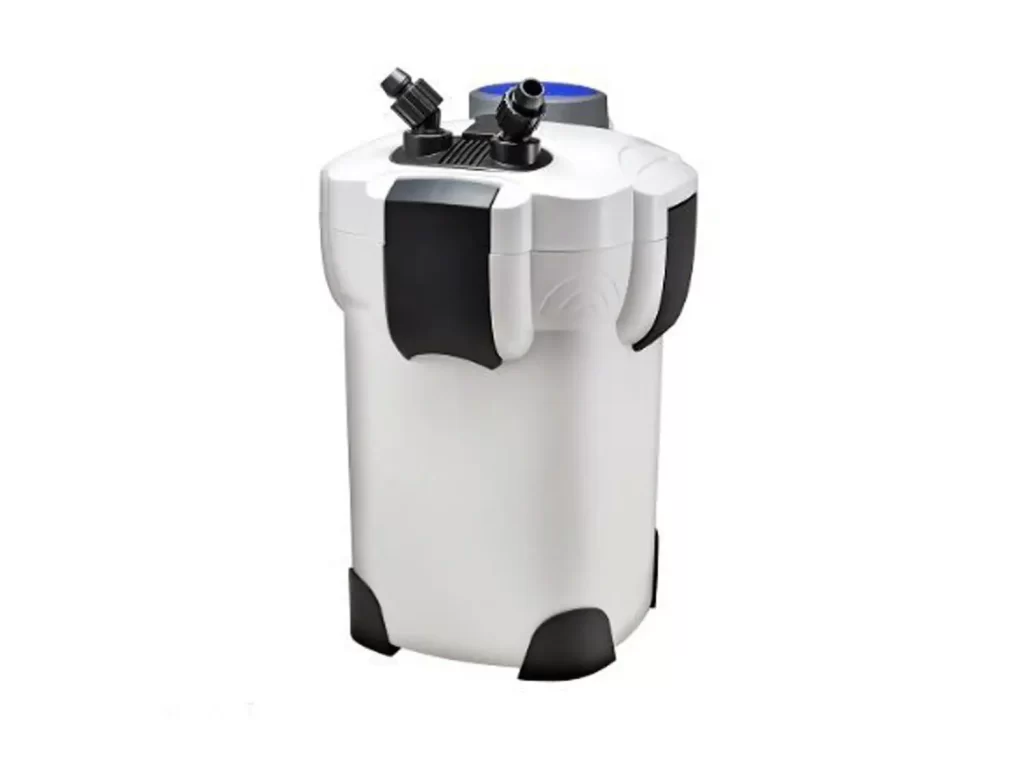
Working Mechanism
- Water is drawn from the aquarium using an intake tube and pumping through filter media inside the canister.
- The filter media can include mechanical, chemical, and biological filtration, depending on the type of media used.
- Then the filtered water is then returned to the aquarium via an outlet tube.
| Pros | Cons |
| Being placed outside the aquarium, canister filters do not take up valuable space inside the tank, providing more room for decorations and aquatic life. | This filter may require more time and effort to set up, clean, and maintain due to its slightly more involved installation and maintenance process. |
| Canister filters are designed to operate quietly, minimizing noise disturbance in the aquarium environment. | Canister filters may have a higher initial cost compared to other filters, which could be a factor to consider for those with limited budgets. |
| These filters often have customizable media baskets, allowing you to choose and arrange filter media to meet the specific needs of your aquarium. | It uses more power than some other filters, which can lead to slightly higher electricity costs over time. |
| This filter is known for its high flow rates, ensuring efficient water circulation and filtration throughout the aquarium. | When a lower flow rate is desired, canister filters may not provide appropriate water movement or circulation in tanks with delicate or slow-swimming fish. |
| It offers filtration through multiple mechanical, chemical, and biological stages, resulting in effective aquarium water purification. | Improper installation or sealing of canister filter components can lead to leaks, risking water damage and compromising aquarium stability. |
Diatomic Filter
A diatom filter is an aquarium filter that uses diatomaceous earth (DE) (a sedimentary rock made from the remains of algae called diatoms) to remove very small particles from the water.
The diatomic filter is placed in line with the filtration system or connected to a canister filter. The DE particles act as a highly effective filter media, capturing and eliminating microscopic impurities like algae and organic waste.
Diatom filters may be more expensive and specialized, but they provide excellent filtration, producing clear and clean water.
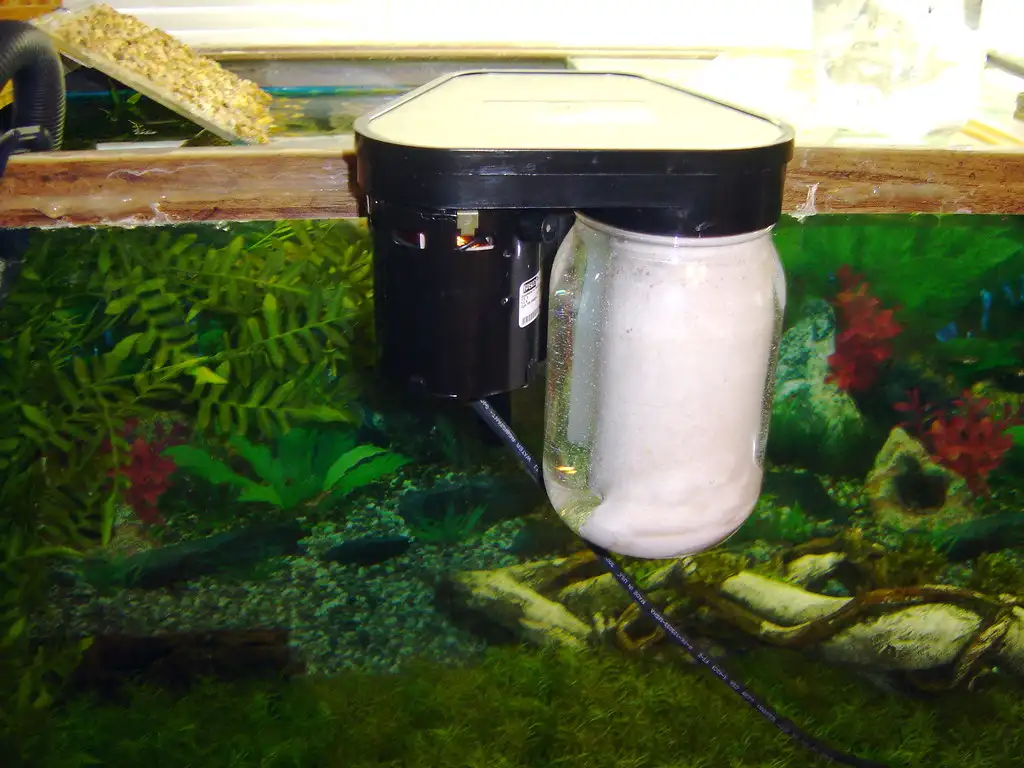
Working mechanism
- It pumps water through a chamber filled with DE.
- The DE acts as a filter media, trapping tiny particles such as algae, bacteria, and other debris that other types of filters may miss.
- As the water passes through the DE, it becomes clearer and cleaner.
| Pros | Cons |
| Diatomic filters can filter out particles as small as 1 micron, making them very effective at removing fine particles from the water. | Overusing a diatomic filter can cause excessive water polishing, which can strip the water of beneficial bacteria and nutrients. |
| They are particularly useful in marine aquariums or aquariums with high bioloads, where water quality is crucial. | The fine powder can clog quickly, so the filter needs to be cleaned frequently. |
| Diatom filters operate without chemicals or medications, making them safe for fish and aquatic inhabitants. | Diatom filters require regular maintenance and cleaning. |
Sponge Filters
A sponge filter is an aquarium filter that uses a sponge as its main filtration material. It is popular for small tanks or tanks with delicate fish, providing gentle filtration and water flow.
The sponge acts as a mechanical filter, trapping debris and particles from the water.
Sponge filters are typically placed directly inside the aquarium, either attached to an air pump or powered by a water pump.
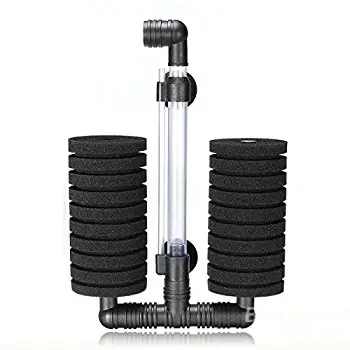
Working Mechanism
- Water is drawn into the sponge filter through a tube or outlet nozzle.
- The water is passed through a sponge, which traps debris and waste.
- Beneficial bacteria grow on the sponge’s surface, breaking down harmful waste compounds and providing biological filtration.
- The filtered water is then returned to the aquarium through an outflow tube.
| Pros | Cons |
| Sponge filters are easy to install and maintain, as they have few moving parts and require no additional equipment. | Sponge filters are excellent for biological filtration but may need extra filter media or methods due to limited chemical filtration capabilities. |
| It provides gentle water flow, ideal for fish species that prefer calmer water currents. | The sponge material of the filter can degrade over time, leading to decreased filtration effectiveness. |
| Sponge filters create water movement at the surface, which enhances oxygen exchange. | Sponge filters may need to be more visually appealing as the sponge material is usually visible in the aquarium. |
| This filter is safe to use in breeding tanks or with small organisms like fry, shrimps, or baby fish, as the sponge material prevents them from being sucked into the filter. | Sponge filters can develop biofilm on the sponge’s surface, which requires periodic cleaning to prevent filter efficiency and water quality degradation. |
Trickle Filter(Wet/Dry)
A trickle, or wet/dry filter, is an external biological filtration system used in aquariums.
This filter employs bio media, such as bio-balls or ceramic rings, to provide a large surface area for beneficial bacteria to colonize.
A trickle filter consists of a wet chamber filled with media and a dry chamber separated by a perforated plate. Water is pumped into the wet chamber, where it trickles down through the media, facilitating the breakdown of harmful compounds by bacteria.
Trickle filters are highly efficient in removing substances like ammonia and nitrite, making them popular for maintaining clean water in aquariums with high bio-loads.
Working Mechanism
- Water is pumped into the wet chamber of the filter.
- The wet chamber contains filter media, such as bio-balls or ceramic rings, which provide a large surface area for beneficial bacteria to colonize.
- As water trickles down through the filter media, it exposes a greater surface area to the bacteria, allowing them to break down harmful compounds.
- Beneficial bacteria convert toxic ammonia into nitrite and nitrite into nitrate, which is less harmful to aquatic life.
- The trickle action of the water provides oxygenation as air is drawn into the dry chamber through perforations or a grid, promoting the growth and activity of beneficial bacteria.
- The continuous water flow prevents the filter media from clogging and ensures efficient filtration.
- Once filtered, the water collects in the lower portion of the filter and can be returned to the aquarium or directed to additional filtration stages.
| Pros | Cons |
| Highly effective biological filtration due to large surface area for beneficial bacteria. | Limited mechanical and chemical filtration capabilities. |
| Efficient oxygenation of filter media promotes bacterial growth. | Requires regular maintenance and cleaning. |
| Suitable for high bio-loads in aquariums and aquaculture systems. | It can be noisy and lead to increased evaporation in the aquarium. |
Sump Filter
A sump filter is an aquarium with all the necessary filtration media, a water pump, and a heater.
What’s great about sump filters is that they’re the most customizable aquarium filters you can have so you can build them according to your preferences.
Typically, sump filters are placed beneath the main aquarium. However, in the past, they were commonly used in marine tanks, where maintaining high water quality is a must.
But nowadays, sump filters are becoming more popular for freshwater tanks, especially those with larger fish, since they offer highly effective and efficient filtration.
If you are interested in the sump system, please read the following article: “Sump Filter.”
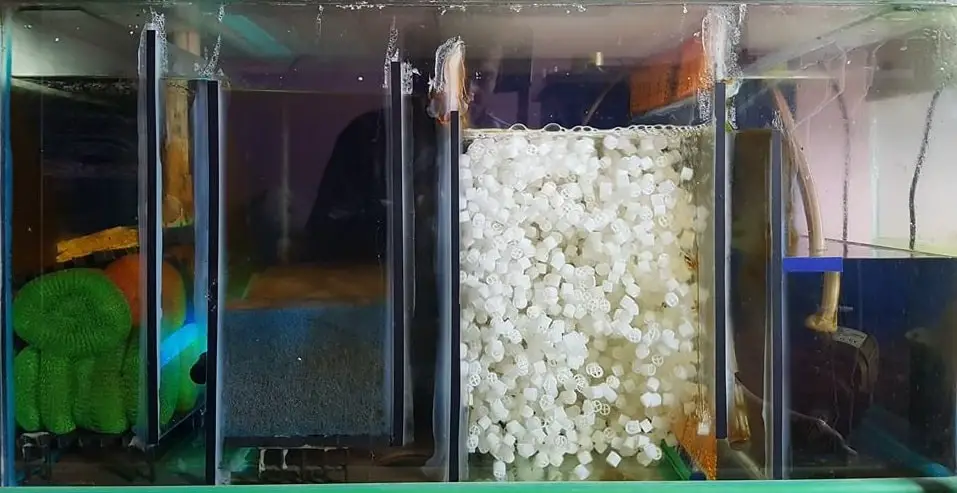
Working Mechanism
- Water from the aquarium is drained down to the sump through an overflow or other mechanism.
- The water passes through a mechanical filter, such as a sponge or floss, which traps debris and waste.
- The water is then passed through a biological filter chamber, such as ceramic rings or bio-balls, where beneficial bacteria break down harmful waste compounds.
- The filtered water is then returned to the aquarium through a pump and return line.
| Pros | Cons |
| Sump filters can filtrate large aquariums, holding much filter media and equipment. | It can be more complex to install and maintain, requiring additional plumbing and equipment. |
| Since the equipment is located below the aquarium, sump filters can operate more quietly than other types of filters. | Sump filters can be more expensive than other filters due to the additional equipment and customization options. |
| Sump filters offer flexibility in designing and customizing the filtration system according to specific needs. | Improper installation or maintenance of the sump filter system can lead to the risk of leaks or flooding. |
UV Filter
A UV filter, also known as an ultraviolet sterilizer, is an aquarium filter placed in the water circulation system. It uses ultraviolet light to eliminate or control harmful microorganisms present in the water.
The UV light disrupts the DNA of bacteria, viruses, and algae, preventing their reproduction and growth.
This filter helps maintain a cleaner and healthier aquatic environment by reducing the risk of disease and algae blooms.
Working Mechanism
- Water passes through a chamber with a UV-C bulb.
- UV-C light kills microorganisms by destroying their DNA.
| Pros | Cons |
| Uv filter purifies the water by reducing green water caused by algae blooms, resulting in clearer and more visually appealing aquarium water. | UV filters are primarily effective against microorganisms but may not remove other impurities such as dirt, dissolved organic compounds, or excess nutrients from the water. |
| UV filters provide a chemical-free water treatment method, avoiding the need for additives or medications that may harm sensitive aquatic organisms. | Improper regulation of water flow or excessive UV light strength in UV filters can affect the colonies of beneficial microorganisms or bacteria. |
| Once properly installed, this filter requires low maintenance and minimal attention and can operate continuously for extended periods. | Over time, the effectiveness of the UV light may decrease, and the UV lamp may require periodic replacement to maintain optimal performance. |
| It can help reduce the risk of waterborne diseases by eliminating or minimizing the presence of harmful pathogens and bacteria. | High levels of dissolved organic compounds, tannins, or suspended particles can limit the penetration of UV light, reducing the effectiveness of UV filters in neutralizing pathogens. |
Which Aquarium Filter Is The Best?
When it comes to choosing the best aquarium filter, it depends on a few factors, like the size of your tank, the flow rate of the filter, and what you specifically need and prefer.
It’s important to ensure that your filter’s flow rate is around five times the size of your tank.
I have been using a sump filter for my 120-gallon tank for a very long time, and these filters are the best option if you have enough room beneath the aquarium.
Sump filters are customizable and can house a variety of filter media, including mechanical, bio, chemical, or UV.
Compared to a canister filter, they are more hassle-free too. Unlike a canister filter, I don’t need to disconnect everything to change the media or any other component on my sump for replacement or cleaning.
If I had to suggest a filter, “Fluval canister filters” are highly regarded and considered among the best options. It has a box-like design and works well for saltwater and freshwater aquariums.
These Fluval canister filters are known for being quiet, powerful, and versatile. However, it’s worth noting that canister filters are more expensive than other filters.
If you’re on a tighter budget, an under-gravel filter is a great alternative that provides reliable filtration at a more affordable price.
However, it’s crucial to consider the specific needs of your tank and the type of aquatic environment you’re creating before making a final decision.
Remember, the most effective filter will depend on tank size, flow rate, filter media options, ease of maintenance, and budget.
Take your time to research and choose the filter that best suits your aquarium’s requirements.
How Long Should I Run My Aquarium Filter Each Day?
You should run your aquarium filter continuously, 24 hours a day, including at night. This is because the filter does more than just keep the water clear.
The aquarium filter also helps create proper water flow, which is crucial for delivering oxygen throughout the tank.
Oxygen is essential for the well-being of your fish and the beneficial bacteria to grow in the tank. In addition, running the aquarium filter continuously removes dirt, waste, and harmful substances from the water.
If you turn off the aquarium filter, the water flow stops and the good bacteria will be in trouble. Even a short time without the filter can make these helpful bacteria die.
When the good bacteria decrease, the ammonia levels in your aquarium can increase and hurt the fish. That’s why it’s important to keep the filter running all the time to keep your aquatic pets healthy.
Here is the article that will guide you on why you shouldn’t turn off the aquarium filter at night.
How Often Should I Clean My Aquarium Filter?
Over time, the filter in your aquarium can get clogged with aquarium waste, making it less effective. The frequency of cleaning your aquarium filter depends on various factors, such as the size of your tank, the number of fish, and the type of filter you have.
In a small tank with just a few fish, waste builds up fast, so you’ll need to clean the filter more often, like twice a month.
But in a big tank with more water, waste spreads out better, so you won’t have to clean the filter as often. In general, cleaning your aquarium filter once a month is recommended.
When cleaning your filter, use the water from your aquarium instead of tap water. Tap water often contains chlorine and other chemicals that can harm the beneficial bacteria in the filter.
Don’t use soap, detergents, or chemicals when cleaning your filter.
Moreover, avoid removing all the beneficial bacteria from the filter media, as a complete removal of bacteria can disrupt the balance of your tank’s ecosystem.
Here is a detailed article on why tap water is unsafe for your fish.
When Should I Replace My Aquarium Filter Media?
Replacing your aquarium filter media depends on the type of media and the condition of your fish tank. If any filter media appears worn out, damaged, or no longer effectively filters the water, it’s time to replace it.
Carbon media requires more frequent replacement among all the filter media due to its higher adsorption capacity. As a result, it becomes saturated with organic material over time, reducing its effectiveness.
Mechanical filter media, like filter floss, catches debris but can get clogged, affecting other types of filtration. You can replace it when it’s worn out or dirty to clean.
In the same way, biological filter media breaks down ammonia but needs replacement when it can no longer do its job effectively. Cleaning it is always an option, but if the waste buildup is excessive, it’s better to replace it.
Regular maintenance and replacement of filter media will ensure your aquarium filter continues to provide optimal filtration for a healthy aquatic environment.
When Should I Change The Filter In My Aquarium?
When your aquarium filter becomes clogged with dust particles and waste materials, it can hinder its ability to clean and maintain good water quality effectively.
You should take action to maintain the health of your fish. Before purchasing a new filter, you can try cleaning it.
Start by rinsing the filter with lukewarm water to remove any buildup. Then, gently squeezing the filter can help dislodge stubborn particles.
If your aquarium filter still looks dirty, it’s time to replace some specific parts, particularly the biological components like bio balls.
The biological parts play a crucial role in filtration. Still, they can get clogged with dirt more often than other filter components.
However, you only have to replace the whole filter system if it’s broken or not working.
If you can’t find a replacement for the damaged filter part, buying a new filter is an option.
Keeping your aquarium filter clean and functional is important for maintaining good water quality and ensuring the well-being of your fish.
Frequently Asked Questions (FAQs)
Here are some frequently asked questions about the aquarium filtration system. They are as follows:
Why Is My Aquarium Filter Producing A Loud Sound?
Almost every filter produces some amount of noise. But, if your aquarium filter produces a louder sound than usual, it may have a huge dirt or clog stuck in it. So, you should turn off the filter and clean it once. Also, too much water flow in the filter may cause splashing noise.
Can I Over Filter My Aquarium?
Yes, it is possible to over-filter an aquarium, but it’s okay. Many aquarists intentionally over-filter their tanks to ensure the water quality remains as high as possible. But, it can create more current and surface agitation, leading to more water evaporation and potentially lower humidity levels in your home.
Conclusion
So, here we come to the end of this article. My final tip is that when purchasing an aquarium filter for your fish tank, the most important factor is the filtration system that suits your aquarium. Of course, you can always go with the filters a little higher capacity than your aquarium requires.
I run many aquariums in my breeding facility and use big sump filters for a group of aquariums. My recommendation is to use a sump system in your aquarium. If not, use a canister filter. Filtration is essential for your fish tank.
I hope this article has made everything clear about aquarium filtration and its types. If you have any queries, please comment in the comment section below. I will be happy to reply to your comments.
Recommended Article:

